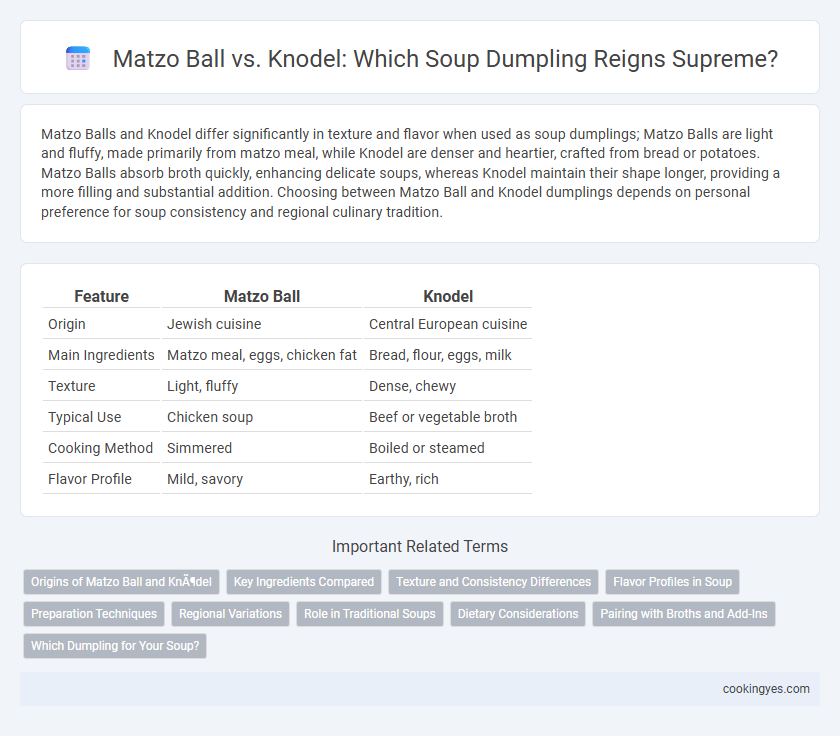Matzo Balls and Knodel differ significantly in texture and flavor when used as soup dumplings; Matzo Balls are light and fluffy, made primarily from matzo meal, while Knodel are denser and heartier, crafted from bread or potatoes. Matzo Balls absorb broth quickly, enhancing delicate soups, whereas Knodel maintain their shape longer, providing a more filling and substantial addition. Choosing between Matzo Ball and Knodel dumplings depends on personal preference for soup consistency and regional culinary tradition.
Table of Comparison
| Feature | Matzo Ball | Knodel |
|---|---|---|
| Origin | Jewish cuisine | Central European cuisine |
| Main Ingredients | Matzo meal, eggs, chicken fat | Bread, flour, eggs, milk |
| Texture | Light, fluffy | Dense, chewy |
| Typical Use | Chicken soup | Beef or vegetable broth |
| Cooking Method | Simmered | Boiled or steamed |
| Flavor Profile | Mild, savory | Earthy, rich |
Origins of Matzo Ball and Knödel
Matzo balls, originating from Ashkenazi Jewish cuisine, are traditional dumplings made from matzah meal, eggs, water, and fat, typically served in chicken soup during Passover. Knodel, hailing from Central European countries like Germany, Austria, and Czech Republic, are dense dumplings crafted from bread or potatoes, often accompanied by hearty meat broths. Both dumplings reflect their cultural heritages and historical contexts, with matzo balls linked to Jewish dietary laws and knodel rooted in rural European peasant traditions.
Key Ingredients Compared
Matzo balls are primarily made from matzo meal, eggs, water, and schmaltz or oil, creating a light and fluffy texture ideal for clear chicken soup. Knodel, traditional Central European dumplings, often use bread or potato as a base mixed with eggs, herbs, and sometimes sausage or bacon, resulting in a denser, heartier dumpling suited for rich broths. The distinct key ingredients directly influence their texture, flavor absorption, and compatibility with different soup styles.
Texture and Consistency Differences
Matzo balls have a light, fluffy texture achieved by using matzo meal, eggs, and oil, making them tender and slightly crumbly, ideal for absorbing broth in soup without becoming soggy. Knodel exhibit a denser, chewier consistency due to their bread or potato base, resulting in a more substantial dumpling that holds its shape firmly in the soup. Texture variability between matzo balls and knodel significantly impacts the mouthfeel, with matzo balls offering a softer bite and knodel providing a heartier, more robust dumpling experience.
Flavor Profiles in Soup
Matzo balls offer a delicate, subtly herbal flavor infused with chicken broth and fresh parsley, creating a light and comforting taste in soup. Knodel dumplings bring a heartier, denser texture with a robust, meaty flavor often enhanced by onions, herbs, and bacon, providing a rich and savory experience. Both complement soups differently: matzo balls enhance clear broths with their tender and airy profile, while knodel add depth and intensity to thicker, stock-based soups.
Preparation Techniques
Matzo Ball preparation involves whisking matzo meal with eggs, water, and fat to create a light, airy dumpling that expands when boiled in broth. Knodel dough, typically made from bread crumbs, flour, eggs, and milk, is denser and requires more kneading to achieve its firm texture, often incorporating herbs or meat. Both dumplings rely on simmering in soup, but matzo balls aim for fluffiness while knodel emphasizes a heartier, more substantial bite.
Regional Variations
Matzo balls, traditional in Ashkenazi Jewish cuisine, are made from matzo meal, eggs, water, and fat, creating light, fluffy dumplings often served in chicken soup during Passover. Knodel, prevalent in Central and Eastern European countries such as Germany, Austria, and the Czech Republic, consist of bread, potatoes, or flour-based dough, offering denser textures and robust flavors, typically accompanying hearty meat soups or stews. Regional variations in ingredients and preparation methods highlight cultural influences and dietary customs, with Matzo balls favoring kosher restrictions while Knodel reflect broader European culinary diversity.
Role in Traditional Soups
Matzo balls play a crucial role in Jewish cuisine, traditionally served in chicken soup during Passover, offering a light, fluffy texture that soaks up the broth's flavors. Knodel, common in Central European soups like Czech or Austrian broth, are denser dumplings made from bread or potatoes, providing a hearty, filling complement to the savory soup. Both dumplings enhance their respective soups by absorbing the broth and adding unique textures, reflecting cultural customs and regional ingredients.
Dietary Considerations
Matzo Ball soup dumplings are typically gluten-free when made with matzo meal, making them suitable for those with gluten intolerance or celiac disease, while Knodel often contain wheat flour or breadcrumbs, posing challenges for gluten-sensitive diets. Matzo Balls frequently use eggs and oil as binding agents, accommodating vegetarian diets but not vegan ones unless modified, whereas Knodel recipes may include dairy and eggs, increasing allergen concerns. Nutritional content differs as Matzo Balls tend to have lower carbohydrate levels and fewer calories compared to Knodel, important for those monitoring macronutrient intake or caloric consumption.
Pairing with Broths and Add-Ins
Matzo balls, traditionally paired with rich chicken broth, absorb the savory flavors, creating a tender, juicy texture enhanced by herbs like dill and parsley. Knodel, especially those made from bread or potatoes, pair well with heartier, meat-based broths such as beef or pork, often complemented by sauteed onions and crispy bacon bits. Both dumpling types benefit from brothy additions that elevate their distinct textures--light and fluffy in matzo balls, dense and chewy in knodel--making them adaptable for diverse soup styles.
Which Dumpling for Your Soup?
Matzo balls and Knodel differ significantly in texture and flavor, influencing your soup experience; Matzo balls are light and airy, ideal for delicate broths, while Knodel offer a denser, heartier bite suited for robust, meat-based soups. Matzo balls use matzo meal and eggs, creating a tender dumpling that absorbs broth flavors without overshadowing them. Knodel, made from bread or potatoes, bring a substantial, rustic character that enriches thicker soups with their chewy consistency.
Matzo Ball vs Knödel for soup dumplings Infographic

 cookingyes.com
cookingyes.com